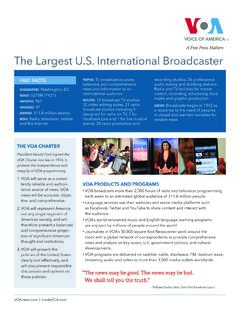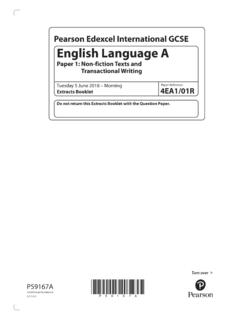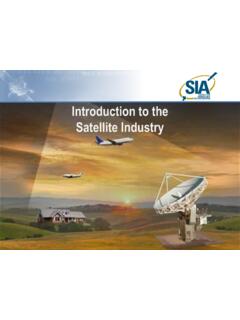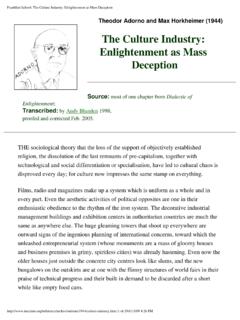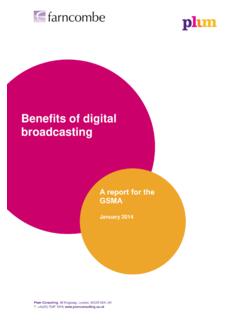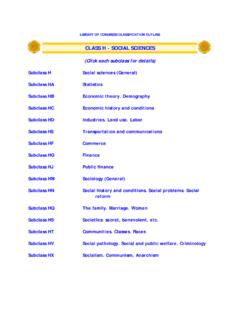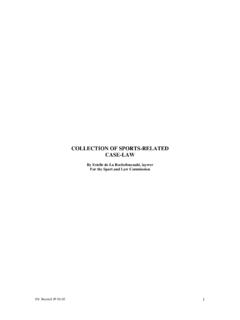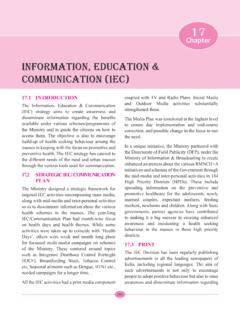Transcription of RADIO HANDBOOK - Maritime New Zealand
1 RADIOHANDBOOKYour guide to marine communicationUPDATED AUGUST 2016DO use VHF channel 16 or the SSB frequency appropriate for your location for distress, safety and calling. On cellphones, call 111 if there is an emergency and you are close to replace your handset correctly when not in use (open microphones are the main cause of serious interference on VHF channels).DO listen before transmitting, to avoid causing interference to use your vessel s name and RADIO callsign. DO use accepted operating procedures and correct procedural words (known as prowords ). Remember that the other station may not use English as its first be brief, because marine RADIO is for shipping business only.
2 If you want to chat, use Citizen Band RADIO or a speak clearly and wait for a reply to calls before transmitting again, or before changing channels or T make long transmissions. Remember that you are blocking the frequency or channel for other users. DON T transmit false or misleading messages. The transmission of a false distress message is an offence under the Maritime Transport T operate your marine RADIO in a way that endangers or interferes with other people or your marine RADIO ALWAYS keep a listening watch on VHF channel 16. The next life saved could be guide to marine communicationAugust 2016 Disclaimer: While all care and diligence has been used in extracting, analysing and compiling this information, Maritime New Zealand gives no warranty that the information provided is without error.
3 Copyright Maritime New Zealand 2016 (Fourth Edition)Parts of this publication may be reproduced, provided this publication and Maritime New Zealand are acknowledged as the New Zealand Level 11, 1 Grey Street PO Box 25620, Wellington 6146 Website: order more copies of this booklet, email your details to 0 - 478 -18816 -1 CONTENTSI ntroduction 3 Maritime RADIO 3 How search and rescue is managed in New Zealand 5 How RADIO works 7 RADIO waves 7 Frequency characteristics 7 Simplex and Semi-duplex VHF RADIO 9 Aerials (antennae) 10 Shielding 10 Distress calls 11 Distress, urgency and safety calls 11 Communicating distress 11 Distress procedure 12 Alarm signal 12 Distress call 13 Distress message 14 Acknowledging a distress message 15 Relaying a distress message 16 Controlling distress traffic 17 Resuming restricted working 18 Resuming normal working 18 Urgency signal and message 19 Safety signal and message 21 Emergency position-indicating RADIO beacons (EPIRBs) 22 Personal locator beacons (PLBs)
4 23 Summary Procedures for distress, urgency and safety communications 24 Using cellphones for distress and urgency calls 26 Using satellite telephones 27 RADIO -telephone procedure 28 Procedural words (prowords) 29 Phonetic alphabet 32 Transmitting numbers (figures) 33 SSB frequencies and VHF channels 34 Using callsigns and IDs 38 Operating procedure 39 Silence period 40 RADIO listening watch 40 Voyage or trip reports 41 Coverage and services 43 Maritime RADIO : VHF and SSB 43 Maritime RADIO VHF coverage 45 VHF broadcasts 46 Taupo Maritime RADIO /ZLM (MF/HF) 47MF/HF broadcasts 47 Warnings 49 Other weather information 50 Medical advice 50 Ionospheric Prediction Services (IPS) 50 Satellite safety services 51 Tsunami warnings in New Zealand 52 Other information 54 Medical evacuation (Medevac)
5 54 Sea rescue by helicopter 55 Working with a helicopter 56 Secrecy of correspondence 57 Transmissions in harbour 57 Testing RADIO apparatus 57 Interference 57 Offences and penalties 58 Useful contacts 59 Glossary of terms 61 Coastal weather forecast areas 65 VHF marine channels 67 RADIO distress calling 68 INTRODUCTIONThis HANDBOOK is a guide for operators of coastal and vessel* RADIO stations, including operators of VHF (very high frequency) and SSB (single sideband, also called MF/HF) radios. It provides information about: how search and rescue is managed in New Zealand distress, urgency and safety calls, including appropriate use of cellphones RADIO -telephone procedures coverage useful contacts and RADIO For seafarers, their vessel s RADIO is their main lifeline to New Zealand s Maritime RADIO Service ( Maritime RADIO ) is responsible for maintaining VHF and HF RADIO services for New Zealand s coastal waters and much of the South Pacific Ocean and Tasman Sea.
6 The services it provides include monitoring RADIO frequencies for distress messages 24/7. The region covered by the New Zealand Distress and RADIO Safety Service is known as NAVAREA XIV and includes percent of the Earth s ocean surface. It extends from the middle of the Tasman Sea to the mid-Pacific Ocean, and from Antarctica to south of the equator. This HANDBOOK This HANDBOOK is a guide for operators of coastal and vessel* RADIO stations, including is a guide for operators of coastal and vessel* RADIO stations, including*Ship (vessel) station Any mobile RADIO station in the Maritime RADIO Service located on board any vessel that is not permanently HANDBOOKM aritime New Zealand (MNZ) is also responsible for broadcasting Maritime Safety Information (MSI) within the NAVAREA.
7 MSI includes meteorological information, coastal and oceanic navigational warnings, ice accretion warnings and ionospheric prediction service provided by MNZ is complemented by a network of volunteer private RADIO operators located around New Zealand and its offshore islands. The network is monitored at all times by staff working at the Maritime Operations Centre (MOC), co-located with the Rescue Coordination Centre New Zealand (RCCNZ) in the Hutt Maritime RADIO Service comprises 30 coastal VHF stations. Of these stations, 28 provide VHF RADIO coverage throughout the coastal waters of New Zealand . The other two stations provide VHF RADIO coverage in the coastal waters of the Chatham Islands.
8 There is also an oceanic MF/HF RADIO station located east of Lake Taupo. All stations are linked to the MOC. It coordinates the transmission of all MSI on voice HF and VHF, as well as navigational warnings broadcast over the Inmarsat SafetyNET satellite system. The scheduled broadcast times, channels and frequencies are shown on pages 46 MOC also provides these services to mariners: telephone patch and message relay facilities for search and rescue and medical purposes on VHF and SSB170 E3 24 S10 S160 E120 W29 S45 S0 120 180 120 XXIVXVXVINAVAREA reception and processing on VHF and MF/HF (SSB) of: trip reports (TRs) ships meteorological observations incoming clearance requests from Customs and the Ministry for Primary search and rescue is managed in New ZealandSRR NEW ZEALANDSRR TAHITISRR EASTER ISLANDSRR HONOLULUSRR FIJISRR NAURUSRR SOLOMON ISLANDSSRR AUSTRALIAWELLINGTONPAPEETESAMOATONGANADI NOUMEANORFOLK ISKERMADEC ISMcMURDOANTARCTICACOOK ISNIUETOKELAU HONIARAR escue Coordination Centre New ZealandSearch and rescue region (SRR) boundariesSearch and rescue regions5 RADIO HANDBOOKThe RCCNZ is responsible for coordinating all major aviation and Maritime search and rescue missions within the New Zealand search and rescue region (SRR).
9 The region extends halfway to Australia, halfway to Chile, and from south of the equator to Antarctica. RCCNZ is also responsible for coordinating land-based missions when an emergency position-indicating RADIO beacon (EPIRB) or personal locator beacon (PLB) is search and rescue efforts coordinated by RCCNZ are called Category II incidents. These incidents arise because an aircraft, vessel or person is in distress, and often require national and international civil and military resources. There are at least two fully qualified search and rescue officers (SAROs) on watch at RCCNZ at any New Zealand Police are responsible for coordinating Category I incidents, which include many Maritime search and rescue missions close to shore.
10 Category I incidents also include land-based search and rescue efforts that do not arise from a distress beacon being activated. RCCNZ frequently provides support and advice to the New Zealand Police during Category I search and rescue information about RCCNZ can be found on Maritime New Zealand s website at If you need advice or assistance, freephone 0508 472 269 or email is also the repository for 406 MHz emergency beacon registrations. Registration is free register at RADIO WORKSR adio wavesRadio transmitters work by supplying a rapidly changing electrical current to an aerial (antenna), to create a changing electromagnetic field. The speed at which these currents change controls the speed at which the electromagnetic field around the aerial changes.






